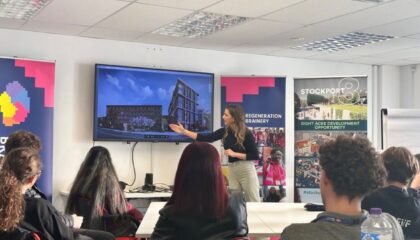Commercial landlords must be aware of serious ongoing safety issues stemming from RAAC,
Building safety within heritage and legacy assets has risen to the top of the news agenda in recent years, largely due to the recognised danger of aluminium composite material (ACM), and other combustible cladding systems. Separately, multiple schools, social housing, and libraries have faced disruption, evacuation, and closure due to the presence of reinforced autoclaved aerated concrete (RAAC).
One year on from the initial furore of summer 2023, it is worth considering the ongoing challenges RAAC presents to the commercial real estate industry.
The dangers of RAAC – especially when exposed to water or within structures that are typically more than 30 years old – have long been recognised, with the Building Research Establishment (BRE) publishing guidance in 1996.
In September 2022, the Office for Government Property (OGP) wrote to several government departments and other public bodies within significant real estate portfolios, highlighting the problems posed by RAAC exposure, asking relevant civil servants to begin noting it, and to take the necessary measures to mitigate against its continued use. Since this notice, RAAC has increasingly been found in public buildings and estates – and continues to cause maintenance problems across the UK.
RAAC and commercial real estate
Within commercial real estate, issues posed by RAAC have played out in a different, yet significant, manner. Though occupying a much larger proportion of the built environment than public estates, commercial assets are structurally less likely to have used RAAC – as they are often smaller, more modular, and less reliant on large concreate roofs and walls than public buildings such as hospitals, schools, social housing or libraries.
The fact that assets in the private sector are likely to have been refurbished and traded more frequently has also reduced the likelihood of RAAC now being present. This is in contrast with cladding remediation, where exposure to ACM has been largely uniform in both private and public schemes.
Faced with potential safety and insurance issues from exposure to RAAC, many property funds and investors began to appoint Workman’s chartered surveyors to conduct building surveys from 2021 onwards.
Supported by technical consultants, these surveys reviewed broad and varying portfolios, which often included assets from all sub-sectors, to establish RAAC exposure and begin remediation work. After more than 300 surveys in a 12-month period, our teams found that exposure to RAAC was extraordinarily rare in stock typically owned by institutional investment – but occasionally very serious.
In the handful of instances where substantial RAAC exposure was found, there was also a lack of conformity in the assets that posed issues. Some were smaller retail units and stores, some were legacy office buildings. More concerningly, others were industrial units that had undergone recent retrofit.
The commercial sector did not only differ from public buildings in terms of breadth of exposure to RAAC. As government bodies are often owner-occupiers, the cost of RAAC remediation in the public sector has largely fallen to local authorities and national government – and as such, it is being completed under large-scale remediation budgets and programmes. Conversely, in the commercial sector, much remediation work is undertaken through the dilapidations process, completed at the end of occupier tenancies.
RAAC in the dilapidations process
During the dilapidations process, disputes can arise between occupiers and property owners over whose obligation it is to remove unstable RAAC within a structure. In many cases, this obligation sits with the occupier, under the provisions of “repair” clauses, often due to the contextual nature of RAAC’s flaws.
In our experience, most RAAC issues are exacerbated by the failure of the occupier to properly maintain the asset’s wider structure, which has allowed deterioration – normally through exposure to moisture – to take place within the RAAC panelling.
To use a comparable example, this is similar to the need for an occupier to replace a warped timber deck – which has become damaged due to a badly maintained and leaky roof – under its “repair and ensure” clause. It is for this reason that, despite the insistence of some occupiers, RAAC exposure is rarely described as an “inherent defect”, to as to be excluded from the provisions of a repair clause.
Building owners may wish to align their approaches to occupiers with the well-established, and respected, agreements used to remediate against wood wool cement slab exposure. Wood wool cement consists of selected wood fibres coated with Portland cement and bonded together under pressure to produce flat slabs. It was previously common within British roofs and external walls due to its fire rating and perceived durability.
However, similar to RAAC, these slabs often faced structural issues when exposed to moisture, and within the dilapidations process it has long been accepted that occupiers should pay for removal where structural issues have arisen due to a failure to maintain water tightness.
Detailed consideration advised
Finally, property owners are seeing a growing number of issues arising from RAAC disputes under the provisions of S18 of the 1927 Landlord & Tenant Act. This section, which places a statutory limit upon the compensation that may be claimed by a building owner when an occupier fails to fulfil their repairing obligations, has been referenced by some occupiers to disincentivise owners from pursuing damages against occupiers.
This has arisen as the cost of RAAC remediation may be higher than the differential between an asset’s value in its current state of disrepair and the value of the asset had it been properly maintained, which is required under S18. With S18 capping compensation at this differential, many occupiers may try to refuse pursuing remediation – instead paying for the capped fee.
At Workman, our position is that courts will give greater credence to the weight of evidence of a property owner incurring a loss by undertaking remedial works, than a hypothetical valuation of what the property might be, whether in repair or not. Therefore, we often advise our clients to take an aggressive posture and argue for needed remediation under their agreed tenancies.
The prevalence of RAAC in commercial premises may be limited, but detailed consideration is strongly advised to avoid serious safety risks and, at the point of lease events or ahead of sale of an asset, a potentially very costly surprise.
National media interest may have subsided, but the challenges posed by RAAC have certainly not.




